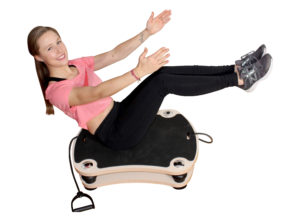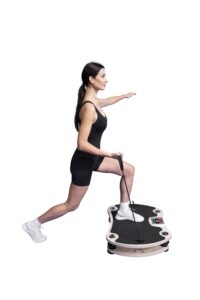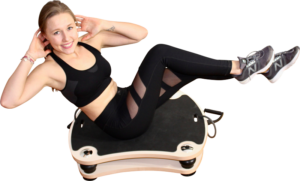Whole Body Vibration—Bone Density

(Excerpted from Becky Chambers book, Whole Body Vibration: The Future of Good Health, Second Edition)
Building Bone Safely and Naturally
WBV is famous for promoting bone growth. Over the last forty years, extensive research has shown that WBV safely promotes and increases bone density, more so than conventional exercise that has long been understood to be essential for healthy bone development. This breakthrough is of critical importance to space travelers who lose bone density at a rate up to 100 times faster than a normal person on Earth.[i] It is also important for postmenopausal women in developed countries who are experiencing epidemic levels of bone loss. Add to this scenario the very real dangers associated with bone density drugs, and you have a life-saving technology that has spurred hundreds of studies and interest worldwide.
Research results with animals and younger people have been dramatic. The development and use of vibration in the 1970s allowed Russian cosmonauts to be in space twice as long as their nonvibrating American counterparts (approximately 200 days versus 100 days). More recently, a NASA website cited the effects of vibration on turkeys, sheep, and rats as “profound,” and stated that “only 10 minutes per day of vibration therapy promoted near-normal rates of bone formation in rats”[ii] under laboratory conditions simulating the zero gravity conditions of space flight. In other research, Dr. Clinton Rubin, Director of the Center for Biotechnology at Stony Brook University, reported decreasing fat in mice by nearly 30 percent and a corresponding increase in bone density with vibration for fifteen minutes a day for fifteen weeks.[iii] A research study with a well-trained cyclist showed an increase in bone density of 1.6 percent in just ten weeks.[iv]
 Since then, there have been numerous studies to pinpoint the best approach for increasing bone density, especially for the populations that need it most such as postmenopausal women and older men, as well as people with health conditions, which led to greater bone loss due to lower activity levels with conditions such as rheumatoid arthritis[v] and cerebral palsy.[vi] A large 2018 systematic review and meta-analysis of the subject that focused on ten clinical trials concluded that “WBV is an effective method to improve lumbar spine BMD [bone mineral density] in postmenopausal and older women and to enhance femoral neck BMD in postmenopausal women younger than 65 years.”[vii]This study concluded that to achieve the best results, a stronger vibration was best and that the frequency should be at least 20 Hz, the amplitude at least 5 mm, a g-force of 8 gs, and the vibration should be used over a long period (more than 108 sessions).[viii]
Since then, there have been numerous studies to pinpoint the best approach for increasing bone density, especially for the populations that need it most such as postmenopausal women and older men, as well as people with health conditions, which led to greater bone loss due to lower activity levels with conditions such as rheumatoid arthritis[v] and cerebral palsy.[vi] A large 2018 systematic review and meta-analysis of the subject that focused on ten clinical trials concluded that “WBV is an effective method to improve lumbar spine BMD [bone mineral density] in postmenopausal and older women and to enhance femoral neck BMD in postmenopausal women younger than 65 years.”[vii]This study concluded that to achieve the best results, a stronger vibration was best and that the frequency should be at least 20 Hz, the amplitude at least 5 mm, a g-force of 8 gs, and the vibration should be used over a long period (more than 108 sessions).[viii]
Searching for these amplitude and g-force numbers when looking for a machine can be counterproductive and confusing, however, since market pressures have led to some companies reporting misleading information. Research, like Western medicine, sometimes may also focus intensely on one health issue, disregarding considerations that are important to the whole person. Exactly what type of vibration is best for increasing bone while still achieving the best overall results remains uncertain. In Vibrant Health’s 2019 survey,[ix] 40 percent of respondents (predominantly older and concerned with bone loss) reported either increased or maintained bone density. These results were obtained using the Vibrant Health Power 1000 vibration machine, which has a lower amplitude and g-force than recommended in the reviewed study discussed above.
Vibrant Health’s survey results for strength, energy, pain reduction, mobility, mood, and sleep are much better than reported in other research, while the bone-density results appear similar. Thus, for total health, including lowering inflammation and pain levels, and brain health, I recommend using a high frequency, mid-range amplitude and g-force, vertical motion vibration machine. Larger, more powerful machines are often too stressful for the body and mind to promote optimal healing.
Protection from Falls
Research with older people and WBV shows improvements in balance along with bone density mass increases. A 2018 study that included the results of seven other systematic reviews about WBV and bone density concluded that WBV enhances muscle strength and balance and helps prevent falls. This large review of studies also found that the results for increasing bone density were not consistent. Later in this chapter, we will talk more about how to best achieve greater bone density, but averting disastrous falls is an excellent outcome in itself. This study summarized the results as follows:
Training with vibrating platforms is reported to have effect on enhancing muscle strength, improving balance, and reducing the risk of fall in osteoporotic patients, while controversial findings on improvement of BMD in different sites were reported.[x]
How WBV Increases Bone Density
Research by Dr. Clinton T. Rubin through his work with Marodyne Medical and the LivMD low-intensity vibration (LIV) device has shown that small, high-frequency signals, a sort of buzz or vibration received from muscle attachments to bone, can cause bone to grow. [xi] Previously, it was thought that high-impact signals were needed to trigger bone growth as would be created by the impact of a person’s foot against the ground. But it turns out that the quivering of muscle fibers against bone as they contract in the process of running—or from vibration—signals bones to increase in density.
WBV provides this same type of small high-frequency signals to many areas and bones intensively, all at once, and with minimal effort. Simply standing on a vibrating plate will cause all muscle fibers connected to weight-bearing bone to involuntarily contract and release twenty to fifty times per second. Different positions are recommended for impacting the arms, hands, wrists, and shoulders (e.g., a push-up) to activate muscles attached to these bones.
The power and size of the vibration machine affect muscle activation and thus the bone density signaling with a greater amplitude vibration, transmitting the signal through more of the body. But very powerful, double motor machines are not necessarily the best choice for your entire body when also considering inflammation levels and your brain (see Double Motor page on this website). These machines are also large, heavy, and expensive. Hence, they are not the best choice for many people.
On the other hand, extremely gentle vibration such as the low-intensity vibration (LIV) (see above) has not been shown to build bone effectively throughout the body for the population who needs it most—postmenopausal women. LIV has been shown to increase bone density in animals—mice,[xii] rats,[xiii] turkeys,[xiv] and sheep[xv]—as well as children with various health conditions.[xvi],[xvii],[xviii] However, these studies are with young subjects (animals or children), and bone building gets considerably harder with age. These research subjects were also smaller in size than adult people (especially the mice and rats), and gentle vibration will travel through the whole body of small subjects much more easily.
What amplitude/g-force vibration is best for increasing Bone Density?
 The issue of what magnitude or g-force vibration is best to use for bone density and WBV in general is tricky, and the health and age of the person using the vibration should also be considered. A new 2023 large, systematic review of bone density research that included twenty-three research studies using varying types of vibration concluded the following with a recommendation of LIV vibration for postmenopausal women:
The issue of what magnitude or g-force vibration is best to use for bone density and WBV in general is tricky, and the health and age of the person using the vibration should also be considered. A new 2023 large, systematic review of bone density research that included twenty-three research studies using varying types of vibration concluded the following with a recommendation of LIV vibration for postmenopausal women:
“At this time, considering the high quality of evidence, it is possible to recommend WBV using high frequency (≈ 30 Hz), low magnitude (≈ 0.3 g), and high cumulative dose (≈ 7000 min) to improve lumbar spine aBMD in postmenopausal women. Other parameters [i.e. types of vibration], although promising, need to be better investigated, considering, when applicable, the safety of the participants, especially in vibrations with higher magnitudes (≥ 1 g).” [xix]
However, this same research also confirmed a greater effectiveness of high frequency, high magnitude vibration for increasing bone density, listing it as the only form of vibration that led to increases in bone density in all three of the bone areas tested: lumbar spine, hip, and femoral neck.
And while LIV has been shown in several studies with adults to “reduce bone loss,” , , reducing bone loss means slowing the rate of bone loss, not gaining bone density. Actually increasing bone density with postmenopausal women and older men is something that studies with LIV have not yet been able to show.
Thus, for reasons of both effectiveness and safety, I recommend high frequency, moderate gravitational force (1.0 g) vibration for most people. The Vibrant Health Power 1000 machine is a popular choice for this type of vibration. It has a large plate and delivers an athletic and versitale workout with a max g-force of 1-1.5g - perfect for bone and mucsle strength as well as many other benefits. If a person cannot handle that much vibration (see Contraindications), starting with very gentle LIV vibration and working your way up is a good recommendation. In this case I would recommend using the Low power setting on the Vibrant Health Ultimate Vibe machine. On the Low setting on this machine you will get a max g-force of 0.3g. this machine also haws a High power setting which will give you the stronger 1.0g force vibraiton - but you have the option to start with the much gentler 0.3g vibraiton.
Vibrant Health’s 2019 survey research results :

For our customers using the Vibrant Health Power 1000 machine and following our guidelines:
40% reported either increased bone density or that they did not lose bone density.
88% of the respondents were ages 50-80.
(click here for live links to most of the following articles)
[i] “Good Vibrations: A New Treatment under Study by NASA-Funded Doctors Could Reverse Bone Loss Experienced by Astronauts in Space,” NASA, November 2, 2001, https://web.archive.org/web/20020209180125/http://science.nasa.gov/headlines/y2001/ast02nov_1.htm.
[ii] “Good Vibrations: A New Treatment under Study by NASA-Funded Doctors.”
[iii] Kolata, “Low Buzz May Give Mice Better Bones and Less Fat.”
[iv] A. Prioreschi et al., “Whole Body Vibration Increases Hip Bone Mineral Density in Road Cyclists,” International Journal of Sports Medicine 33, no. 8 (August 2012): 593–99, https://doi.org/10.1055/s-0032-1301886.
[v] Prioreschi, “In Patients with Established RA, Positive Effects.”
[vi] Kate Ward et al., “Low Magnitude Mechanical Loading Is Osteogenic in Children with Disabling Conditions,” Journal of Bone and Mineral Research 19, no. 3 (2009): 360–69, https://doi.org/10.1359/JBMR.040129.
[vii] Elena Marín-Cascales et al., “Whole-Body Vibration Training and Bone Health in Postmenopausal Women: A Systematic Review and Meta-Analysis,” Medicine 97, no. 34 (August 2018): e11918, https://doi.org/10.1097/MD.0000000000011918.
[viii] Marin-Cascales et al., “Whole-Body Vibration Training and Bone Health in Postmenopausal Women.”
[ix] Chambers and Chaddha, “Effects of Whole Body Vibration Using the Vibrant Health Power 1000.”
[x] Maria Grazia Benedetti et al., “The Effectiveness of Physical Exercise on Bone Density in Osteoporotic Patients,” BioMedResearch International 2018, https://doi.org/10.1155/2018/4840531.
[xi] Kolata, “Low Buzz May Give Mice Better Bones and Less Fat.”
[xii] C. T. Rubin et al., “Adipogenesis Is Inhibited by Brief, Daily Exposure to High-Frequency, Extremely Low-Magnitude Mechanical Signals,” Proceedings of the National Academy of Sciences 104, no. 45 (2007): 17879–84, https://doi.org/10.1073/pnas.0708467104.
[xiii] Clinton Rubin, Gang Xu, and Stefan Judex, “The Anabolic Activity of Hone Tissue, Suppressed by Disuse, Is Normalized by Brief Exposure to Extremely Low-Magnitude Mechanical Stimuli,” The FASEB Journal 15 (October 2001), https://faseb.onlinelibrary.wiley.com/doi/epdf/10.1096/fj.01-0166com.
[xiv] Y. X. Qin, C. T. Rubin, and K. J. McLeod, “Nonlinear Dependence of Loading Intensity and Cycle Number in the Maintenance of Bone Mass and Morphology,” Journal of Orthopaedic Research 16, no. 4 (1998): 482-489, https://doi.org/10.1002/jor.1100160414.
[xv] Clinton Rubin et al., “Low Mechanical Signals Strengthen Long Bones.” Nature 412 (2001): 603–604. https://doi.org/10.1038/35088122.
[xvi] Ward et al., “Low Magnitude Mechanical Loading Is Osteogenic.”.
[xvii] T. P. Lam et al., “Effect of Whole Body Vibration (WBV) Therapy on Bone Density and Bone Quality in Osteopenic Girls with Adolescent Idiopathic Scoliosis: A Randomized, Controlled Trial,” Osteoporos International 24 no. 5 (2013): 1623–1636, https://doi.org/10.1007/s00198-012-2144-1.
[xviii] M. L. Bianchi et al., “Effects of Low-Magnitude High-Frequency Vibration on Bone Density, Bone Resorption and Muscular Strength in Ambulant Children Affected by Duchenne Muscular Dystrophy,” Journal of Bone and Mineral Research 28, no. 5 (2013), https://www.cochranelibrary.com/central/doi/10.1002/central/CN-01064425/full.
[xix] Regina Dantas Jales de Oliveira et al., “Effectiveness of Whole-Body Vibration on Bone Mineral Density in Postmenopausal Women: A Systematic Review and Meta-Analysis of Randomized Controlled Trials,” Osteoporosis International 34 (2023): 29–52, https://doi.org/10.1007/s00198-022-06556-y.
“I went from only 61% of normal bone density, to 105% of normal bone density in two and a half years, using only Whole Body Vibration and natural supplements! I was originally diagnosed with “extremely severe osteoporosis” and now the bone density test came back saying I have “the bones of a healthy young woman!” Before I started the doctor said I could easily have a “spontaneous crushing fracture” coughing or going over a bump in the car. I used to put my older grandchild in the stroller and push him around. Now I pick up the younger one without a thought.”
—Mary Oronato, 70 years old
ex-Osteoporosis patient
My doctor said it was impossible to build bone density at my age and wanted me to take Fosamax. The side effects concerned me. I did research and wanted to try a more natural approach to see if it could make a difference. I decided to do my own experiment and see if a vibration plate would make a difference. I'm excited to report my results. My only change has been using the Vibrant Health Power 1000 Vertical Vibration Platform Machine. For the past six months after purchasing, I used it one to two times a day for five minutes each session. My results are below:
After fracturing two elbows, I had a bone density DXA scan on 9/28/20 showing osteoporosis, age 63
Lumbar Spine T-score +0.5
Hip T-score -2.0 osteopenia
Femoral Neck -2.9 osteoporosis
My follow-up scan on 7/30/21 had amazingly improved. Age now: 64 years old
Lumbar Spine T-score = +0.8, Normal improvement of 0.3
Hip T-score -1.6, improvement of 0.4
Femoral Neck T-Score - 2.3 osteopenia, improvement of 0.6
Went from osteoporosis to osteopenia in six months. Pretty incredible considering the doctor said it wouldn't be possible. Well worth the money for this type of improvement!
I'll stick with the natural method and let them keep the meds and side effects.
P. Weber, age 64
—P. Weber, age 64
“After a year of using the vibration machine, my bone density increased by 6% in both my hip and spine. When I reported the results to a doctor in my family, he called it 'a massive increase in the world of bone density.”
—Diane Warshovsky, age 68
"I've been using the BV1000 vibration machine since 2008. I had been diagnosed with osteoporosis many years earlier when I was in my 40's. I have never taken any osteoporosis drugs, but I have been taking a lot of natural supplements for many years. I am now in my mid-70's and according to a recent bone density test I have the bones of a healthy 40 year old. The technician who read my results just about fell on the floor! Based on my bone density test she was sure I couldn't be older than 65."
—Anna Wall, mid-70's
"I just got my Dexa scan results back, and the technician noted significant changes in my lumbar spine density (increase of 5.3%) and an increase of 1.2% in my right hip. Yay!!! However, he noticed a decrease in my left hip (6.7%). My left hip has been weak for years, and my doctor says it is because my right hip is bearing more of the weight. He said I am much stronger on one side (in my case, the right), and told me this is normal. He suggested I do squats and lunges while holding weights to improve the left hip. I will be doing those on my VH 1000.
"I have been using the VH 1000 for about 6 months, and I am firmly convinced all the improvement has to do with that. I have had osteopenia since 1999, and I have never had an improvement in my score until this last Dexa scan."
--- Paula Maixner

